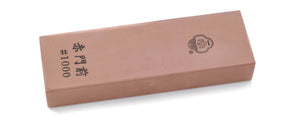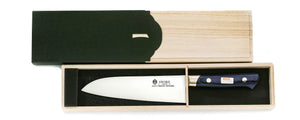
Montanren Series
Some of the highest quality forged knives available, with supreme hardness and toughness levels. With higher hardness and wear resistance than Blue Steel #2, the edge retention is significantly boosted, making this knife perfect for those who cook for long periods and need a knife to stay sharp for the entire session. A wavy pattern called a "Montanren" is visible on the back of the knife; our Montanren Series gets its name from this very pattern. This wave is the boundary between the softer iron and harder carbon steel and is reminiscent of patterns found on traditional Japanese swords.
| Product number | Actual Blade Length (mm) | Full Length (mm) | Total Weight (g) |
|---|---|---|---|
| 1dm7-240 | 240 | 400 | 300 |
| Blade | Material Name | Handle |
|---|---|---|

Single Edged |
Blue Steel #1 | Yew octagonal handle |

Mioroshi
Mioroshi Deba's shape looks like a fusion of Deba and Yanagiba. It is slimmer and thinner than Deba. It is suitable for filleting and slicing fish in pieces but not suitable for cutting bones due to its thinness.It has become popular in the last few years with fish mongers due to the longer blade making it much easier to work with.

Blue Steel #1
A harder version of Blue Steel #2. While chip-resistant with amazing edge retention, you need to know how to sharpen properly to use it.
Carbon Steel
Blue Steel #1 also contains trace amounts of tungsten and chromium for hardness and toughness, but has more carbon than Blue Steel #2. This makes Blue Steel #1 even harder, leading to better sharpness and edge retention. This steel is recommended for those who want a premium cutting experience, but also need a knife with a long lasting edge. Truly a steel for professionals.
*NOTE: Carbon Steel is susceptible to rust if it is not properly cared for. Please clean and dry the blade regularly during use and after use.

Yew octagonal handle
Handle
These handles are made from Yew wood, this wood was historically used in European Longbows due to its density, strength and rot resistance. It was also used by Prince Shotoku , a regent in the Japanese Court.This wood is characterized by its beautiful grain and a color that darkens with age.

Forge Welded
Forging Process
A forge welded blade is essentially a blade made of more than one billet of steel. There are many variations of technique and steel combinations. At its most simple, a forge welded blade is two billets of steel heated and hammer together to form one unified piece. The steel will then be shaped by hammer into the desired blade shape. Hardened and tempered, then ground, sharpened and polished. A forge welded blade has higher strength and edge retention than a stamped blade.

Optional Engraving
Optional Engraving Service
Sakai Ichimonji provides complimentary engraving using either Japanese Kanji or English Alphabet. Please specify your preference. For details, please visit here
A knife store that has supported the history of knives and food culture in Japan.
It has been 600 years since the birth of swordmaking in the Sakai region of Japan. Sakai Ichimonji Mitsuhide's and it's craftsmen continue to build on that legacy by producing the finest blades in Japan.
This is where the culture of completing a dish of sashimi by "just cutting" and the culture of expressing sharpness as "taste" was born.
For 70 years, we have been connecting the spirit of Sakai's craftsmen with the passion of chefs in Osaka's kitchen equipment shopping district, known as the kitchen of Japan.
We are very happy that our knives can be used by people all over the world.
Precautions
After use, wash off any dirt and wipe thoroughly with a dry cloth to remove any moisture. This product is not for use with frozen foods.This product is handmade, so each piece will be different. Please use the weight and length listed as a guide. Each material is natural and may vary in color. It is not the same as the picture.We take great care with our inventory, but in the unlikely event that we are out of stock, we will contact you by email to let you know.















































